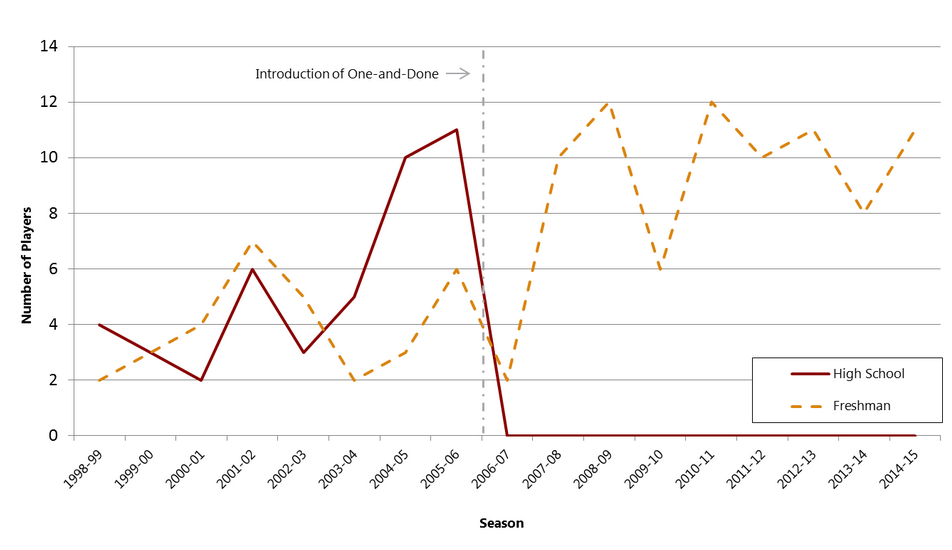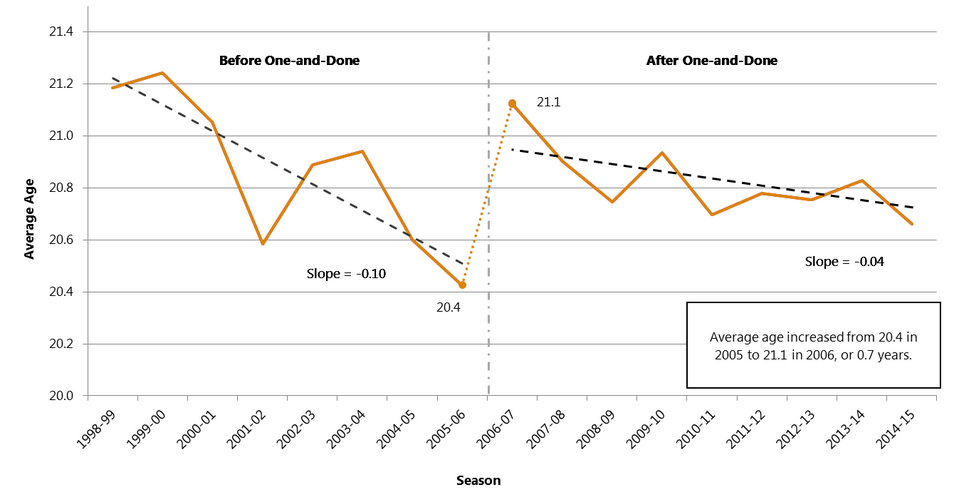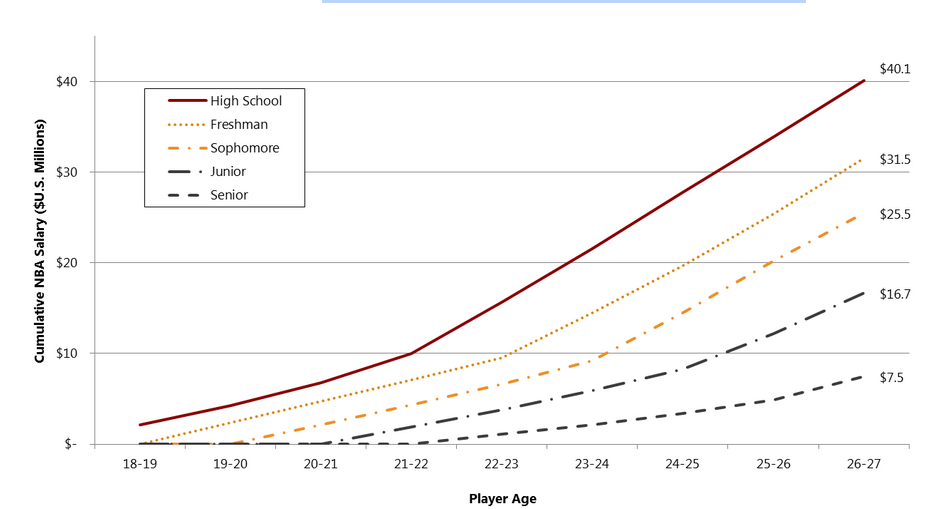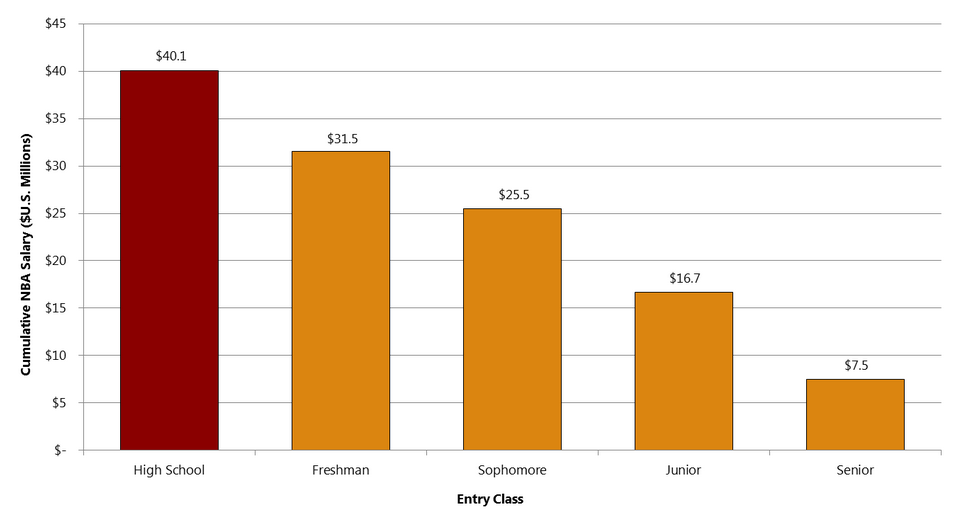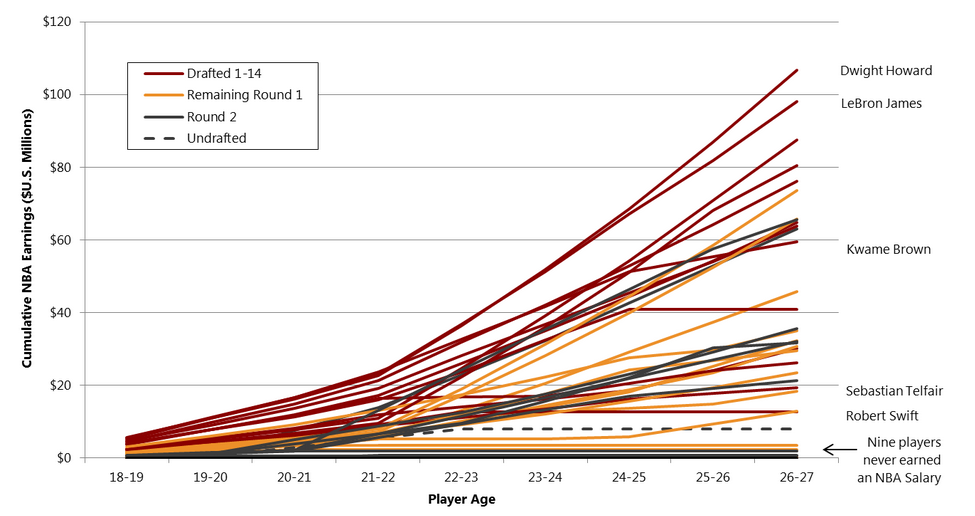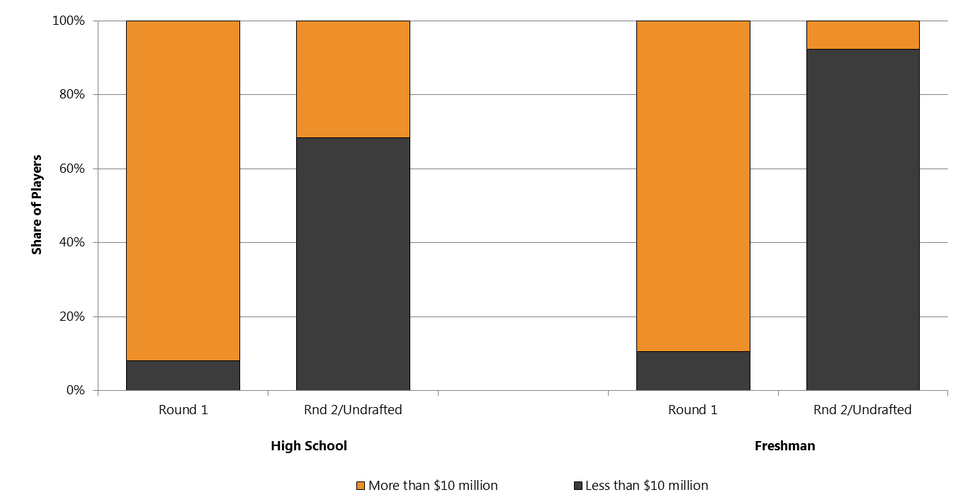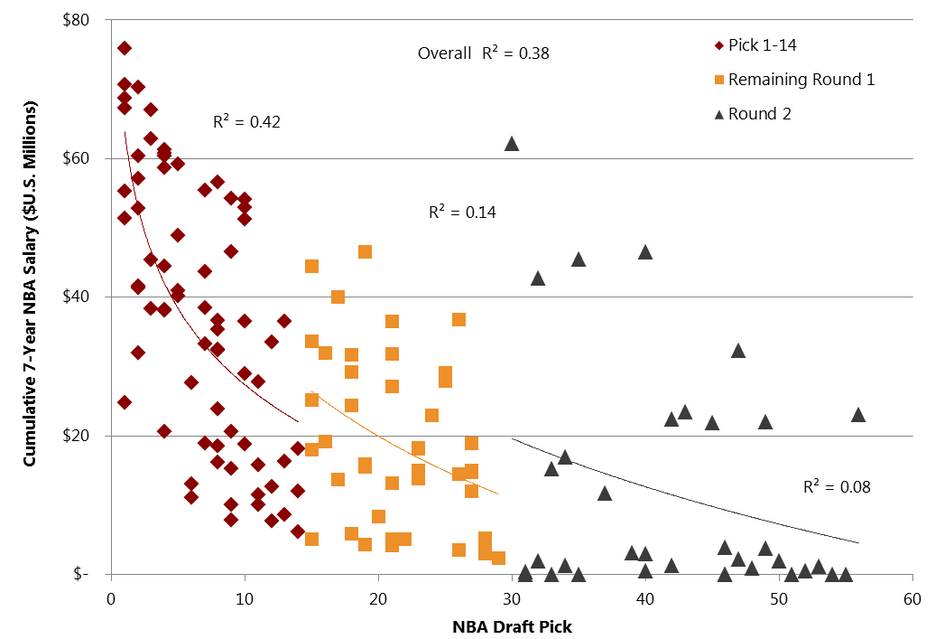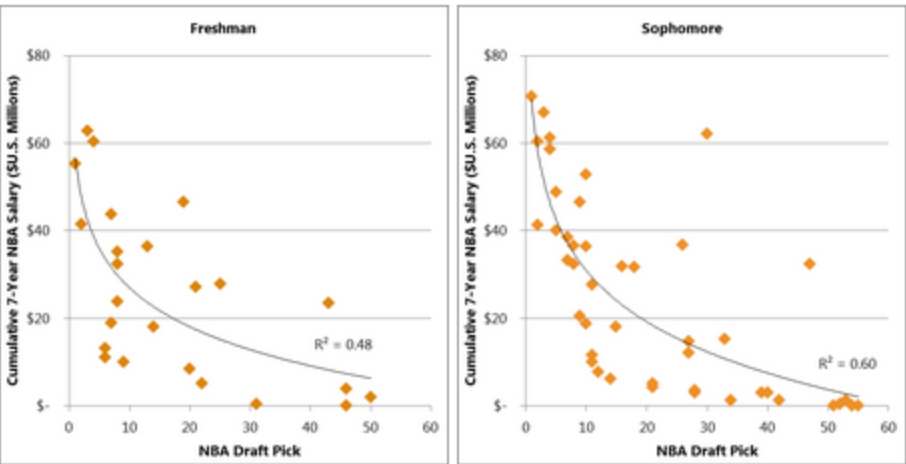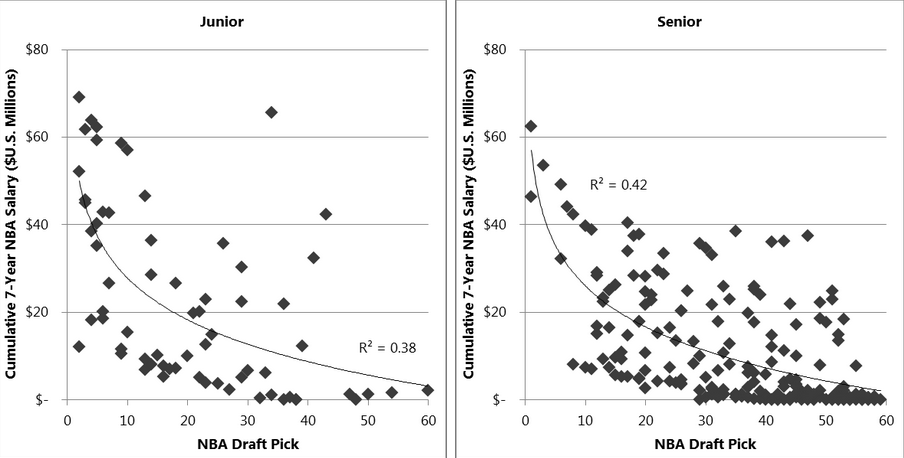 I get pretty tired of all of the complaining about One and Done. It’s time to do something about it.
I get pretty tired of all of the complaining about One and Done. It’s time to do something about it.
The current rule is a prime example of what happens when two sides are negotiating several major issues simultaneously and a point that deserves a fully thought-out plan becomes something to compromise over. A rule gets made that doesn’t address the actual issues very well, causing distress on all sides.
So what’s the plan? How does one actually come up with a system that makes sense? Today I will discuss the results of my in depth study of the issues that I did with my company, Intensity Corporation (www.intensity.com). Tomorrow I will lay out a recommendation for a plan that may be a basis for a win/win agreement. Clearly any final agreement is up to the players and the league to negotiate.
The first step in solving any problem is actually knowing what question you are trying to answer. In this case it’s ”How can a series of rules be created that address the needs of all sides creating a win-win solution?”
So a brief recap of yesterday’s column spells out the greatest need of all the sides.
The players are looking for a market-based system that allows NBA ready players to maximize their earnings. They want to be able to enter the league at a time when they have the highest chance for long-term success. For some that is directly out of high school. For others the NCAA is the best place to develop. No one wants players to be set up to fail by entering the league prematurely.
The NCAA wants top talent to play for one of their schools as long as possible. NCAA basketball is a billion dollar industry. Longer player careers mean more money for them. Especially since the superstar players focusing on a pro career essentially play for room and board.
The NBA wants as much certainty as possible. Their belief is that longer college careers make players easier to draft successfully. Drafting potential is a risky business full of unknowable issues. How can they minimize their risk of investing millions into players who might be busts?
With each side’s priorities clearly spelled out, it is time to start thinking about the best way to maximize the benefits for each. The current problem is the system has its incentives misaligned with the desired outcomes of the parties.
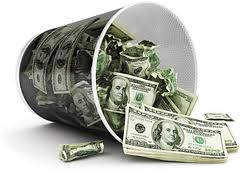 The players want the ability to earn money but are prohibited from doing so in the NCAA. Currently, pro ready talent must “donate” a years worth of service to the NCAA system.
The players want the ability to earn money but are prohibited from doing so in the NCAA. Currently, pro ready talent must “donate” a years worth of service to the NCAA system.
Both the NCAA and the league want players to benefit by staying in college longer. However, the system has little financial incentive to do so. The opposite is actually true. Players are prohibited from earning any money besides the value of a scholarship. This incentive is at direct odds with the league’s desired outcome.
The league wants as much draft certainty as possible. Teams believe that more years of evaluation means better clarity of player skills which should equal better draft outcomes.
We now approach the discussion with data analysis. Which points are supported by the data and which aren’t? Knowing the answers in as unbiased a form as possible will go a long way to clarifying which features need to be included in any final agreement to make it as balanced as possible.
On a personal note, I am both an 18-year playing veteran and have a family history in the game that dates back to the founding of the league. I am very interested in what’s good for the game and its players. A successful system must work for everyone.
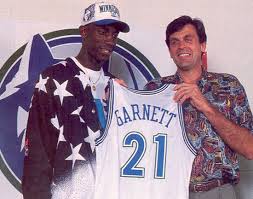 To truly understand the forces at work, it is critical to be as thorough and unbiased as possible. Our study is based on the following features:
To truly understand the forces at work, it is critical to be as thorough and unbiased as possible. Our study is based on the following features:
We studied the outcomes of every player since 1998 that declared early entry for the draft, was drafted, or earned an NBA salary after completing their NCAA eligibility. That equals 1,417 players studied from both before One and Done and after. We are interested in direct measures of players’ market value. We used their draft position as a measure of potential value as determined by NBA teams. We used their season and career earnings as a measure of their realized potential. After all, a player’s real value is what someone is willing to pay them. We purposefully did not use player statistics or awards as a measure of their value. These measures are too arbitrary and dependent on outside factors. All dollar values are converted to 2013 dollars for comparison purposes to account for the rise in salaries during the study. Any foreign players who did not play in the NCAA were excluded from the study as they are not affected by the early entry policy.
So its time for the big reveal. Drum roll …
How do players entering the draft as high schoolers or college freshman make out? Are they ready or not? Is the road littered with failing players who should be in college?
Item #1: There is a clear trend that more players are entering the draft at younger and younger ages. No big surprise here. Since 1998 there has been an increase in the number of players entering the draft from high school and after their freshman year with a consistent decrease in the average age of draft entrants (not counting the bump when One and Done was implemented). Clearly the lure of NBA riches is very strong compared to the minimal compensation that players receive in college. With the large jump in the salary structure in coming years under the league’s new TV deal, this effect is only expected to grow.
Figure 1: Number of High School and Freshman Entrants
Figure 2: Average Age of Draft Entrants
Item #2: Players entering the draft earlier make more money in their careers. Players entering the draft later, on average, never make up the difference. Players who enter the draft earlier have extra earning years and get to free agency faster than players who stay in college longer. Keep in mind that the top players self select to enter the draft each year. That means that each successive group has the top 10 to 15 players removed. In theory, by the time players reach their junior year, the top 30-40 would-be juniors have already entered the NBA, reducing the talent pool.
Figure 3: Average Cumulative Salary by Age
Figure 4: Average Cumulative Salary Nine Years after High School
Item #3: There is a huge spread of outcomes for young players entering the league. Tracking high school entrants from age 18-27 before one and done shows a range of outcomes from players earning over $100 million to zero.
Figure 5: Salary through Nine Years: High School Draft Entrants
There is a very high correlation between draft success and financial success. That means that while many players who entered from high school had great outcomes, several did not. Approximately 90% of players who were 1st Round picks earned over $10 million in their first 9 years in the league while the vast majority of high school and freshman entrants who were selected in the 2nd Round or not at all had relatively unsuccessful careers.
Figure 6: Percentage of Draft Entrants Who Earned More Than $10 Million
These items demonstrate clearly that top players are able to compete out of high school and have successful careers. This can be explained by the fact that players today commit to year-round playing much earlier. Some players are getting better coaching and playing full time from the time they are around 10 years old. Players are getting as much development time by high school as college seniors of 30 years ago did.
They have a very real financial incentive to enter the league as soon as they are able to compete on an NBA level. Each year spent in college carries an opportunity loss in the millions of dollars in salary and endorsements that will most likely not be made up. With the new TV deal on the horizon, the “cost” of attending college will rise considerably.
It also shows that players who are not 1st round picks tend to struggle and may benefit from additional development in college. There are only very few players who succeed on a high level but some players are NBA ready as early as 18 years old.
The next issue we look at is the draft outcomes of young versus more mature players.
Does delaying entry into the league help teams draft better? Are older players easier to identify as pro-ready than younger players? Did this change with One and Done? Will two years of college make a difference?
We looked at this question by comparing the teams projected value of a player (draft pick) with the players realized value (total earnings) to determine how teams did by class and draft position. The league claims that older players are easier to identify since teams have more information on them. What does the math say?
Item #1: Teams are very good at identifying talent in the lottery. We divided draft picks into three categories and compared the correlation between draft pick and earnings for each group. The group made up of lottery picks shows high correlations between draft pick and career earnings. The rest of the 1st round showed a sharp dropoff in a team’s ability to identify talent effectively. Picking in the 2nd round is about as effective as throwing darts at the scouting manual. Historically there is almost zero correlation for 2nd round picks.
Figure 7: Correlation between Draft Pick and Earnings through Seven Years
Item #2: Historically teams have virtually the same success rates at drafting players regardless of how many years they spent in college. As seen in the charts below, the range of draft success is similar regardless of the entry age of the player. That means that teams are just as good as selecting high school players and college freshmen as they are at selecting seniors. Actually, statistically they are a little better at predicting success of younger players than they are for older players. This may be explained by the fact that young players self select to enter the draft and the pool is focused on just the elite talent.
For a more detailed explanation of R-squared value please review the material at the end of the column.
Figure 8: Correlation between Draft Pick and Earnings through Seven Years in the NBA: Pre One-and-Done Players
Item #3: Teams’ ability to draft did not improve after the implementation of One and Done. If anything, teams statistically do a worse job today than they did as a group 10 years ago.
Figure 9: Correlation between Draft Pick and Earnings through Seven Years
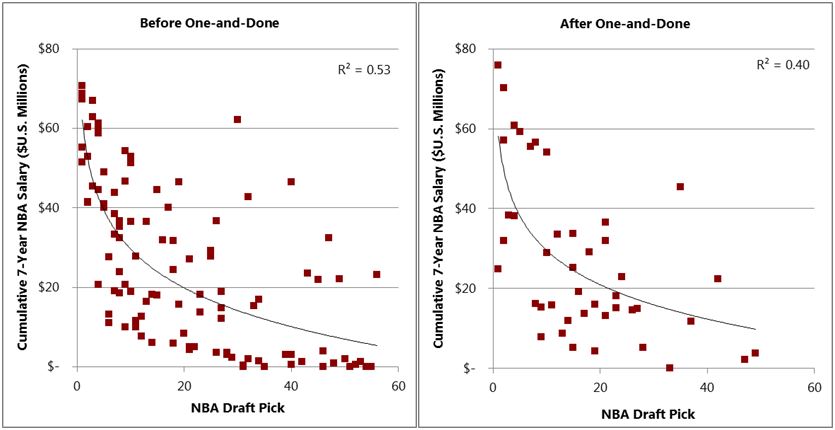
What all of this means in English is that teams do a pretty good job of identifying top talent and drafting well. After about the 10th-15th pick, depending on the draft, the odds of drafting a quality player diminish quickly. By the second round the ability of teams to correctly identify talent is very low. According to the data, this result is independent of the player’s age. Teams are no better at picking seniors than they are at picking 18 year olds. Statistically at least, there is no justification that teams need additional years to determine if a player is an NBA talent.
Simply put, drafting young players who have never played in the NBA is a noisy process. Many of the key issues are unknowable or up to chance. Things like injury potential, team chemistry, and other intangibles are really difficult to predict. The more talented a player is, the better. But that is only a part of what ultimately makes a player great.
So if you add these factors together, a comprehensive and balanced policy would have an element to allow identifiable star talent entry into the league while incentivizing other players to develop in college. It is in everyone’s interest that players who would benefit more in the NCAA system thrive there rather than struggling or failing in the pros.
To make a balanced win/win system you need several elements. Tune in tomorrow for Danny’s magic formula…
To download the full study go to:
http://intensity.com/news/one-and-done/
(RELATED: ONE AND DONE: A DATA-DRIVEN ANALYSIS: PART ONE)
A brief explanation of R-squared
One argument for a delayed entry policy is that NBA teams have limited information about high school entrants, so it is difficult for teams to project the value of these players and make accurate picks. To test this argument, we assess how accurately NBA teams project player value by regressing cumulative salary on log (draft pick). Draft pick indicates the NBA’s projected value of a player, and cumulative salary indicates his realized value. The R-squared values from these regressions measure how well draft pick relates to future salary. Therefore, a higher R-squared suggests that NBA teams are more accurate in projecting the future value of players.
Danny Schayes is a Director of Business Optimization at Intensity and a leader in the business of professional sports. Schayes frequently advises sports organizations in complex business matters that include contract negotiations, pricing strategy, marketing optimization, and executive leadership. Follow him on Twitter.
